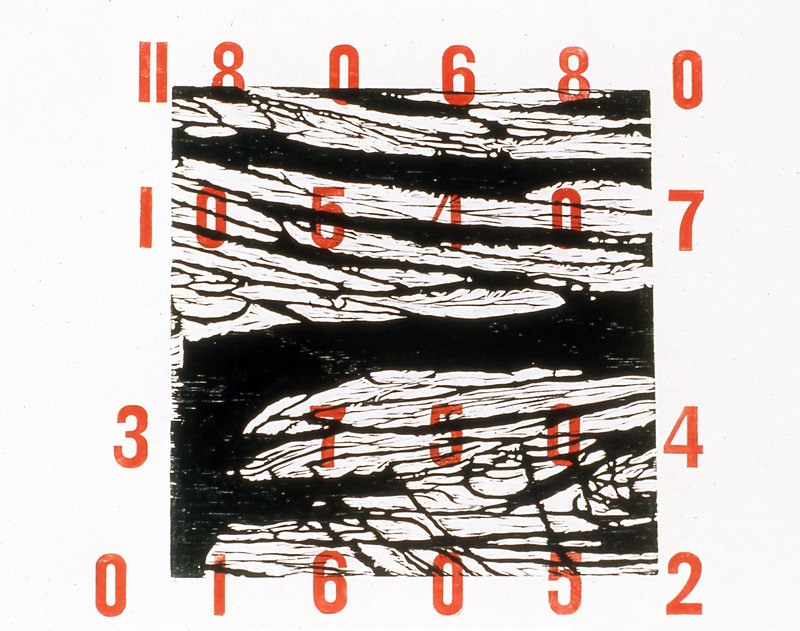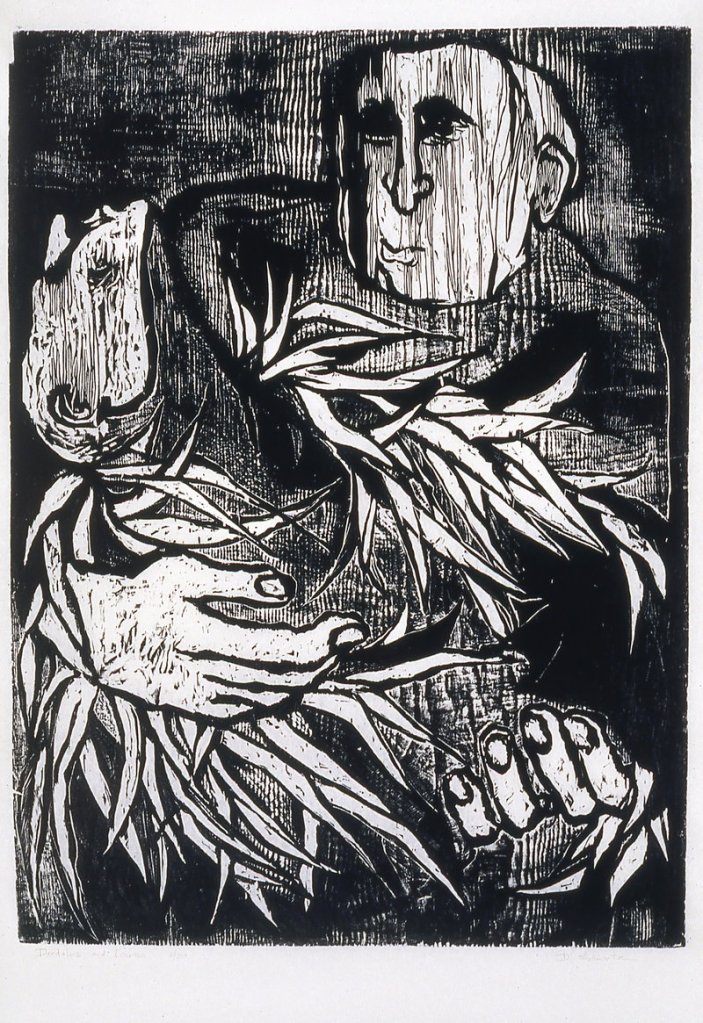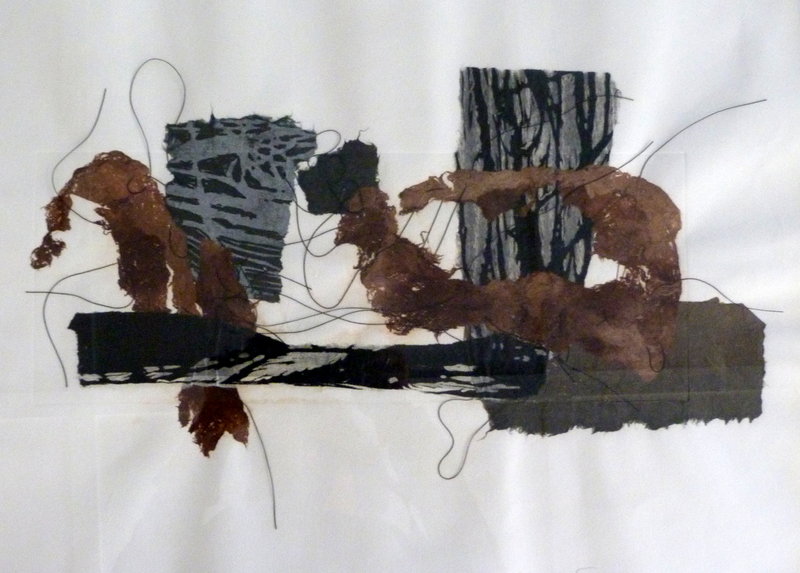Dorothy “Deedee” Schwartz was a 19-year-old student when she produced her first significant woodblock print under Leonard Baskin (1922-2000).
Yes, that Leonard Baskin.
Schwartz’s 1957 “Daedalus and Icarus” is startlingly powerful and impressively proximate to Baskin’s work. A version of the print is accompanied by the wood block from which it was pulled. Together, these greet the viewer as you first step into the Maine Jewish Museum.
Daedalus was held prisoner by King Minos, who, according to myth, sent human sacrifices to be devoured by the half-man, half-bull Minotaur for whom Daedalus created the Labyrinth. Daedalus also made wings of wax and feathers so he and his son Icarus could escape. Icarus ignored his father’s warnings and flew too close to the sun; the wax then melted and Icarus fell to his death.
The fall of Icarus is a beloved art subject and Schwartz’s version (for me) is only surpassed by Pieter Breughel’s, in which the fatal fall goes unwitnessed behind a busy, working landscape. Schwartz shows a parent holding his dead child in a scorching (but stilled) moment of self-examination. He meets our eyes as though his own in a mirror. We become Daedalus, the tragic creator of dangerous inventions. This, we see, is the price of revolution or playing God.
Schwartz never puts down her moral mirror of self-examination. It is her guide for the unblinking exploration of herself — spiritually, culturally and philosophically — her Charon.
That “Daedalus” put Schwarz on this path becomes clear through her lithographs after self-portraits (actually done from mirrors) of great women artists: Berthe Morisot, Artemesia Gentileschi, Kaethe Kollwitz, Paula Modershohn-Becker and the unsung Renaissance portraitist Sofonisba Anguissola. These pared-down prints might not be the flashiest corner of Schwartz’s career, but her well-considered admiration comes through in spades. They comprise standards — moral mirrors — for Schwartz.
Schwartz’s free-thinking self-awareness isn’t limited to women, however. She has a particular thing for Charles Darwin. Besides portraits of him and a boldly fascinating (but quietly smart) series about his garden, a key print is her blow-up of the most famous page from Darwin’s notebooks. It begins with “I think” and shows (the first?) map of evolutionary dissemination (i.e. a fractal Boolean tree branch system). Schwartz’s print gathers meaning as it reveals the printers dots from the book from which the image was copied. There is an awkward moment (imagine introducing Andy Warhol to Walter Benjamin) in which Schwartz takes the singular/romantic and electrically transforms it into the universal/scientific. It’s a revolutionary moment and it’s what Schwarz does best.
What looks like a diverse show thus becomes surprisingly coherent. The artist’s dreams about fish, for example, reveal psychological self-examination: Barbed wire appears, and this in turn gives her river water scenes dynamic mental meaning. Her “Southern Sheriff” is a cruel Bull Connor character, but oddly self-indicting with his single, mirror-eye gaze.
This is where Schwartz pulls away from the pack. She can see a moral degenerate like Bull Connor in herself and portray this unflinchingly.
Schwartz’s most powerful series is a trio of large squares with plenty of paper breathing room around simple, superimposed geometrical forms. “Badge” puts one of her square, abstract river scenes over a yellow Star of David — the badge the Nazis forced Jews to wear. Another is “Tyranny of Numbers” which features a grid of digits that in this context immediately brings to mind concentration camp arm tattoos (although, alone it might elicit the digital world, social security numbers, colonialist identification systems, passwords, credit cards, etc). But this brings us to the core of Schwartz’s moral mirror. While I had a fleeting moment of American pride about our nation’s heroic struggle against the Nazis, the third print unearths a torrent of moral conflict: “Hiroshima.” It is a red circle with the black woodcut/river square over it. Could the atomic bomb be our wings of wax?
On one level, Schwartz’s overlay of two images seems so simple, but it’s not as easy as thesis/antithesis. Instead, she seems to be saying our culture is a complex and multifaceted mirror of ourselves. It’s not even that we are shades of gray but, rather, competing and conflicting inclinations, voices and histories. A mirror, she hints, doesn’t just show us the present, but the scars of our past and the direction of our future (all reversed — like prints). Schwartz’s leitmotif is the never-still river of life — gurgle-murmuring but ever effervescent.
Schwartz is never shrill or self-righteous. We are fractured but all-connected in her print collages such as “9/11” — a dancing modernist labyrinth of torn-paper abstract forms, all threaded together like a jazzy tune.
Even where Schwartz could have been angry, her compassion prevails: “PTSD Bosnia” could seethe in rage about the perpetrators, but we never lose sight of the victims — who need us. And it is this kind of insight from Schwartz’s moral mirror in which we find profound ideas: She helps us understand it is our compassion that gives humanity meaning. It drives our culture to see the world around us. It explains why people and culture are good.
“Evolution” can be a tough show at times, but it’s powerful and beautiful — morally as well as aesthetically — and well worth a visit.
Freelance writer Daniel Kany is an art historian who lives in Cumberland. He can be contacted at:
dankany@gmail.com
Send questions/comments to the editors.





Success. Please wait for the page to reload. If the page does not reload within 5 seconds, please refresh the page.
Enter your email and password to access comments.
Hi, to comment on stories you must . This profile is in addition to your subscription and website login.
Already have a commenting profile? .
Invalid username/password.
Please check your email to confirm and complete your registration.
Only subscribers are eligible to post comments. Please subscribe or login first for digital access. Here’s why.
Use the form below to reset your password. When you've submitted your account email, we will send an email with a reset code.